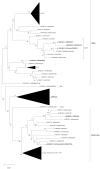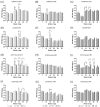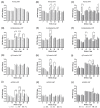Heterologous Prime-Boost Vaccination with Commercial FMD Vaccines Elicits a Broader Immune Response than Homologous Prime-Boost Vaccination in Pigs
- PMID: 36992134
- PMCID: PMC10058820
- DOI: 10.3390/vaccines11030551
Heterologous Prime-Boost Vaccination with Commercial FMD Vaccines Elicits a Broader Immune Response than Homologous Prime-Boost Vaccination in Pigs
Abstract
Three commercial vaccines are administered in domestic livestock farms for routine vaccination to aid for foot-and-mouth disease (FMD) control in Korea. Each vaccine contains distinct combinations of inactivated serotype O and A FMD virus (FMDV) antigens: O/Manisa + O/3039 + A/Iraq formulated in a double oil emulsion (DOE), O/Primorsky + A/Zabaikalsky formulated in a DOE, and O/Campos + A/Cruzeiro + A/2001 formulated in a single oil emulsion. Despite the recommendation for a prime-boost vaccination with the same vaccine in fattening pigs, occasional cross-inoculation is inevitable for many reasons, such as lack of compliance with vaccination guidelines, erroneous application, or change in vaccine types by suppliers. Therefore, there have been concerns that a poor immune response could be induced by cross-inoculation due to a failure to boost the immune response. In the present study, it was demonstrated by virus neutralization and ELISA tests that cross-inoculation of pigs with three commercial FMD vaccines does not hamper the immune response against the primary vaccine strains and enhances broader cross-reactivity against heterologous vaccine antigens whether they were applied or not. Therefore, it could be concluded that the cross-inoculation of FMD vaccines can be used as a regimen to strategically overcome the limitation of the antigenic spectrum induced by the original regimen.
Keywords: cross-inoculation; foot-and-mouth disease virus; heterologous prime-boost; homologous prime-boost; serological performance.
Conflict of interest statement
The authors declare no conflict of interest.
Figures





Similar articles
-
Evaluation of Swine Protection with Three Commercial Foot-and-Mouth Disease Vaccines against Heterologous Challenge with Type A ASIA/G-VII Lineage Viruses.Vaccines (Basel). 2024 Apr 29;12(5):476. doi: 10.3390/vaccines12050476. Vaccines (Basel). 2024. PMID: 38793727 Free PMC article.
-
Cross-protective efficacy of the O1 Manisa + O 3039 bivalent vaccine and the O 3039 monovalent vaccine against heterologous challenge with FMDV O/Jincheon/SKR/2014 in pig.Vaccine. 2019 Mar 14;37(12):1702-1709. doi: 10.1016/j.vaccine.2018.11.080. Epub 2019 Feb 1. Vaccine. 2019. PMID: 30712811
-
Evaluation of swine protection with foot-and-mouth disease O1/Campos and O/Primorsky/2014 vaccines against the O Mya-98 lineage virus from East Asia.Vaccine. 2021 Mar 19;39(12):1701-1707. doi: 10.1016/j.vaccine.2021.02.025. Epub 2021 Feb 20. Vaccine. 2021. PMID: 33618945
-
Foot-and-Mouth Disease Virus: Immunobiology, Advances in Vaccines and Vaccination Strategies Addressing Vaccine Failures-An Indian Perspective.Vaccines (Basel). 2019 Aug 16;7(3):90. doi: 10.3390/vaccines7030090. Vaccines (Basel). 2019. PMID: 31426368 Free PMC article. Review.
-
Targeted FMD Vaccines for Eastern Africa: The AgResults Foot and Mouth Disease Vaccine Challenge Project.Viruses. 2021 Sep 14;13(9):1830. doi: 10.3390/v13091830. Viruses. 2021. PMID: 34578411 Free PMC article. Review.
Cited by
-
Optimizing rabies mRNA vaccine efficacy via RABV-G structural domain screening and heterologous prime-boost immunization.NPJ Vaccines. 2025 Mar 2;10(1):43. doi: 10.1038/s41541-025-01098-w. NPJ Vaccines. 2025. PMID: 40025078 Free PMC article.
-
Virulence and Immune Evasion Strategies of FMDV: Implications for Vaccine Design.Vaccines (Basel). 2024 Sep 19;12(9):1071. doi: 10.3390/vaccines12091071. Vaccines (Basel). 2024. PMID: 39340101 Free PMC article. Review.
-
Evaluation of a Vaccine Candidate Designed for Broad-Spectrum Protection against Type A Foot-and-Mouth Disease in Asia.Vaccines (Basel). 2024 Jan 9;12(1):64. doi: 10.3390/vaccines12010064. Vaccines (Basel). 2024. PMID: 38250877 Free PMC article.
References
-
- Pereira H. Foot-and-mouth disease. In: Gibbs EPG, editor. Virus Diseases of Food Animals. Academic Press Inc.; New York, NY, USA: 1981. pp. 333–363.
-
- WOAH WOAH Terrestrial Manual Foot and Mouth Disease (Infection with Foot and Mouth Disease Virus) [(accessed on 11 January 2023)]. Available online: https://www.woah.org/fileadmin/Home/eng/Health_standards/tahm/3.01.08_FM....
Grants and funding
LinkOut - more resources
Full Text Sources

